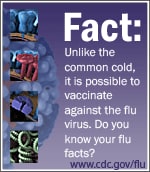The Truth About Flu Vaccine Safety and Use
I ran across a blog, “Setting the record straight: Debunking ALL the flu vaccine myths“. Given that we are in the midst of the flu season, I thought it would be worth sharing this information with you. It appears to be very well done and can help you understand some of the common misconceptions people have about flu vaccination.
Click on the Fact graphic if you want to test your knowledge about influenza and immunization with a short quiz from the CDC:

When you are done, go get a flu shot!
Some related links:
CDC Seasonal Flu Website
Seasonal Flu Information for Workplaces and Employers
What’s New on Seasonal Flu (check back regularly!)
Questions and Answers about Seasonal Flu
What You Should Know about Flu Antiviral Drugs Fact Sheet
National Business Group on Health, Vaccinating Against the Flu: A Business Case
Image courtesy of Brooklyn Community Board 14.


Careful, friends. This link is total bunk. Thorough bunk. But, bunk none-the less. Here is one actual study from The US NATIONAL LIBRARY OF MEDICINE AND NATIONAL INSTITUTE OF HEALTH that shows that 75% of the deaths from influenza are 65 and older. And, that there is NO discernible (or helpful) effect in this age group. http://www.ncbi.nlm.nih.gov/pubmed/17897608 . This matters because they are the majority and this is more than just opinion.
John Q,
Not bunk. More recent data from October 2013 journal article on this issue available at: http://www.ncbi.nlm.nih.gov/pubmed/24146855, provides the following conclusion:
“By using confounding-reducing techniques with 15 years of provincial-level data including vaccination and health outcomes, we estimated that influenza vaccination prevented ∼4% of influenza-associated hospitalizations and deaths occurring after hospitalizations among older adults in Ontario.”